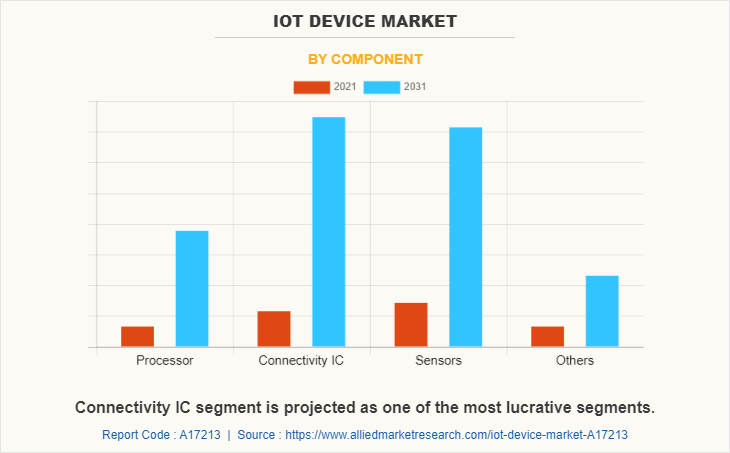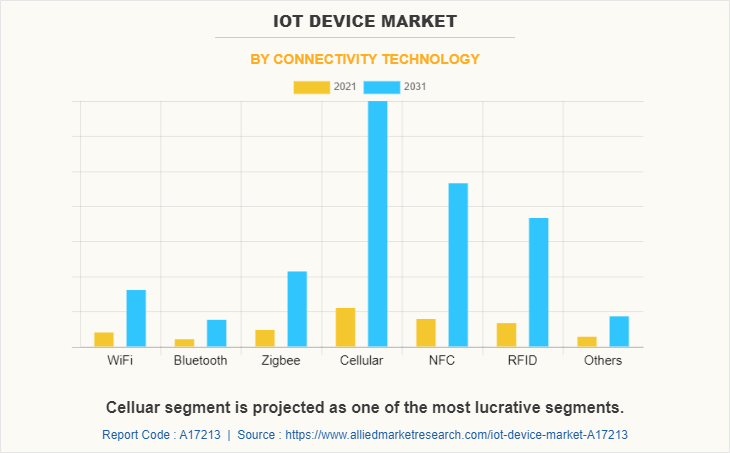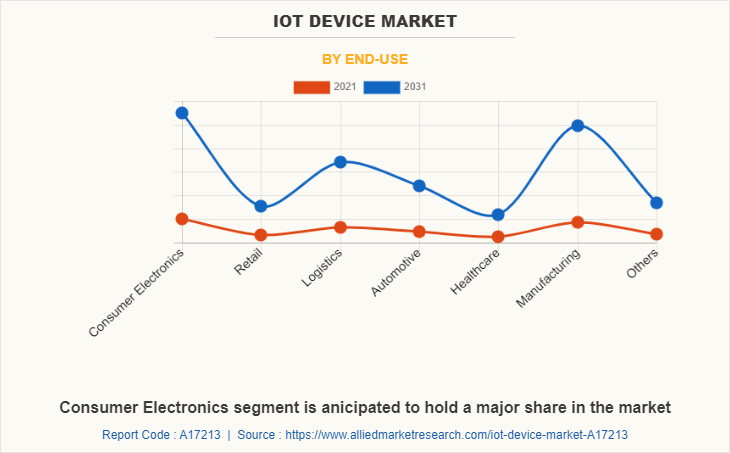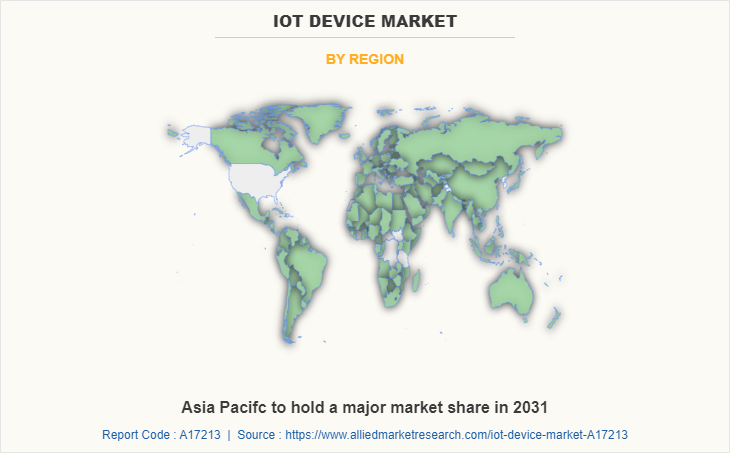IoT Device Market Research, 2031
The global IoT device market size was valued at $77.8 billion in 2021, and is projected to reach $413.7 billion by 2031, growing at a CAGR of 18.6% from 2022 to 2031. Internet of Things devices are connected to the Internet and equipped with sensors to transmit data to other devices. The Internet of Things devices include computer devices, wireless sensors, software, actuators, and more. Further, IoT devices can range from simple household cooking appliances to complex industrial tools. Each IoT component has a unique identifier (UID) and can transmit data without the need for human intervention.
In addition, IoT devices consist of sensors to collect critical data, which is then transformed into valuable insights to increase the efficiency of manufacturing operations. Rise in demand for consumer electronics, such as smartphones, laptops, tablets, and others, creates significant growth opportunities for the IoT device industry.

The IoT device market size is expected to witness notable growth during the forecast period, owing to a rise in the penetration of smart devices and an increase in spending on IoT technologies by end users. Furthermore, an increase in the adoption of 5G technologies, especially in developed countries, has driven the Internet of Things devices market growth. Moreover, the availability of advanced telecom infrastructure is expected to propel the Internet of Things devices market growth during the forecast period.
However, the lack of standardization in Internet of Things protocols is acting as one of the prime factors that restrain the Internet of Things devices market growth. On the contrary, a surge in demand for smart infrastructure solutions across end-user verticals is expected to provide lucrative opportunities for the growth of the Internet of Things devices market during the forecast period.
The Internet of Things devices market is segmented based on component, connectivity technology, and end use. Based on component, the market is divided into processor, connectivity IC, sensors, and other components. The sensors segment dominated the market, in terms of revenue, in 2021, and is expected to follow the same trend during the forecast period. By connectivity technology, the market is fragmented into Wi-Fi, Bluetooth, Zigbee, Cellular, NFC, RFID, and others. The cellular segment dominated the IoT device market opportunity in 2021 and is expected to dominate the market in the coming years. By end use, the market is bifurcated into consumer electronics, retail, enterprise, building monitoring, logistics, and others. The consumer electronics segment acquired the largest share in 2021, and the BFSI segment is expected to grow at a high CAGR from 2022 to 2031.
Segment Overview
The IoT device market share is segmented into Component, Connectivity Technology, and End-Use.
By Component, the market is segmented into processor, connectivity IC, sensors, and others. The sensors segment was the highest revenue contributor to the market, with $24,454.6 million in 2021. Owing to the rapid reduction in the sensor size and high adoption of microelectromechanical systems (MEMS) technology, sensors are finding applications in automotive, healthcare, and consumer products. Thereby contributing to the growth of the IoT devices market. The connectivity IC segment is estimated to grow at a significant CAGR of 18.85% during the forecast period, owing to wireless technologies, such as wireless local area network (WLAN), Wi-Fi, Bluetooth, cellular, and low-power wireless rely heavily on connectivity ICs.

By Connectivity Technology, the market is bifurcated into Wi-Fi, Bluetooth, Zigbee, cellular, RFID, NFC, and others. The cellular segment was the highest revenue contributor to the IoT device market size, with $18,653.2 million in 2021. Cellular IoT is the technology that connects physical objects to the Internet, utilizing the same cellular network that is currently used by smartphones. The rise in penetration of smartphones across emerging economies is significantly boosting the growth of the Internet of Things devices market. Furthermore, the NFC segment is anticipated to grow at a significant CAGR of 17.68% during the forecast period. This growth is attributed to the application of near-field communication technology in consumer & commercial applications due to its features, such as high-speed connectivity in short range, seamless connectivity, and operational efficiency

By end use, the Internet of Things devices market is divided into in consumer electronics, retail, enterprise, building monitoring, logistics, and others. The consumer electronics segment is anticipated to grow at a significant rate with a CAGR of 18.37%, owing to factors such as the adoption of digital devices and the rise in the number of Internet users. In addition, growing consciousness about fitness and a surge in disposable incomes in emerging economies boost the overall market growth as well.

Region-wise, IoT devices market trends are analyzed across North America (the U.S., Canada, and Mexico), Europe (the UK, Germany, France, and the rest of the Europe), Asia-Pacific (China, India, Japan, South Korea, and the rest of the Asia-Pacific), and LAMEA (Latin America, the Middle East, and Africa). North America, specifically the U.S., remains a significant participant in the global IoT devices industry. Major organizations and government institutions in the country are intensely putting resources into the technology

Significant factors that impact the growth of the Internet of Things devices market include a rise in connected devices to drive the IoT device market growth, coupled with unleashing a massive 5G Internet of Things ecosystem and critical communication services. Moreover, the availability of high-speed connectivity is expected to drive the market opportunity. However, a lack of standardization in Internet of Things protocols is acting as a prime barrier for early adoption, which hampers the growth of the market. On the contrary, the surge in demand for smart infrastructure solutions is expected to offer a potential growth opportunity for the Internet of Things devices market during the forecast period.
The key players that operate in the market include, Cisco, Cypress Semiconductor Corporation, Intel Corporation, MediaTek Inc., Microchip Technology Inc., Microsoft Corporation, NXP Semiconductors N.V., Smith Micro Software, Inc., IBM Corporation, Bosch Security Systems GmbH, Aeris Communications, Inc., Advantech Co. Ltd., Sigfox, Quectel, Qualcomm, Renesas Electronics Corporation, and Texas Instruments Inc
Key Benefits For Stakeholders
- This report provides a quantitative analysis of the market segments, current trends, estimations, and dynamics of the IoT device market from 2021 to 2031 to identify the prevailing IoT device market opportunities.
- The market research is offered along with information related to key drivers, restraints, and opportunities.
- Porter's five forces analysis highlights the potency of buyers and suppliers to enable stakeholders to make profit-oriented business decisions and strengthen their supplier-buyer network.
- In-depth analysis of the IoT device market forecast segmentation assists in determining the prevailing IoT device market opportunity.
- Major countries in each region are mapped according to their revenue contribution to the global market.
- Market player positioning facilitates benchmarking and provides a clear understanding of the present position of the market players.
- The IoT device market overview includes the analysis of the regional as well as global IoT device market trends, key players, market segments, application areas, and market growth strategies.
IoT Device Market Report Highlights
| Aspects | Details |
| By Connectivity Technology |
|
| By Component |
|
| By End-Use |
|
| By Region |
|
| Key Market Players | QUALCOMM Incorporated, Cypress Semiconductor Corporation, Microchip Technology Inc., Texas Instruments Inc., Microsoft Corporation, Cisco Systems Inc., Intel Corporation, renesas electronics corporation, NXP Semiconductors N.V., MediaTek |
Analyst Review
According to the insights of CXOs of leading companies, Internet of Things devices technology is witnessing a significant rise in consumer electronics applications, such as smartphones, laptops, and other portable devices. The number of Internet of Things devices has increased substantially in industrial sectors, owing to rise in demand for Industry 4.0 initiatives globally. In addition, rise in demand for the smart infrastructure and artificial intelligence solutions across the automotive, industrial, and healthcare sector is anticipated to drive the growth of the Internet of Things devices market in the coming years.
The Internet of Things devices market is highly competitive, owing to the strong presence of existing vendors. Internet of Things devices vendors, who have access to extensive technical and financial resources, and are anticipated to gain a competitive edge over their rivals, as they have the capacity to cater to the market requirements. The competitive environment in this market is expected to further intensify with increase in technological innovations, product extensions, and different strategies adopted by key vendors.
The rise in demand for consumer electronics drives the need to enhance Internet of Things devices solutions, such as in-home system and fifth generation network solutions. Moreover, prime economics, such as the U.S., plan to develop and deploy next-generation Internet of Things device-based applications across various sectors. For instance, in June, 2021, ExteNet Systems, a provider of LTE/5G and fiber neutral host communications infrastructure solutions, deployed a private wireless network at the AT&T Center in San Antonio, Texas, home of the San Antonio Spurs. The deployment is part of a partnership between ExteNet and Spurs Sports & Entertainment (SS&E), which is anticipated to provide lucrative opportunities for the market growth.
Among the analyzed regions, the U.S. exhibits the highest adoption rate of Internet of Things devices and has experienced massive expansion of the market. On the other hand, Mexico is expected to grow at a faster pace, predicting lucrative growth due to rise in investment by prime players in Internet of Things solutions.
The key players profiled in the report include, Cisco, Cypress Semiconductor Corporation, Intel Corporation, MediaTek Inc., Microchip Technology Inc., Microsoft Corporation, NXP Semiconductors N.V., Smith Micro Software, Inc., IBM Corporation, Bosch Security Systems GmbH, Aeris Communications, Inc., Advantech Co. Ltd., Sigfox, Quectel, Qualcomm, Renesas Electronics Corporation, and Texas Instruments Inc.
The growth of the Internet of Things devices market is majorly driven by the availability of high-speed connectivity paired with rise in connected devices to drive the growth of IoT. Further, unleashing a massive 5G Internet of Things ecosystem and critical communication services is anticipated to drive the growth of Internet of Things devices market.
The sensors segment was the highest revenue contributor to the market, with $28,411.9 million in 2021
North America was the highest revenue contributor, accounting for $26,248.6 million in 2021, and is estimated to reach $122,446.5 million by 2031, with a CAGR of 17.02%.
The global IoT device market was valued at $77,750.7 million in 2021, and is projected to reach $413,670.6 million by 2031, registering a CAGR of 18.58%
The leading companies includes Cisco, Cypress Semiconductor Corporation, Intel Corporation, MediaTek Inc., Microchip Technology Inc., Microsoft Corporation, NXP Semiconductors N.V., Smith Micro Software, Inc., IBM Corporation, Bosch Security Systems GmbH
Loading Table Of Content...



